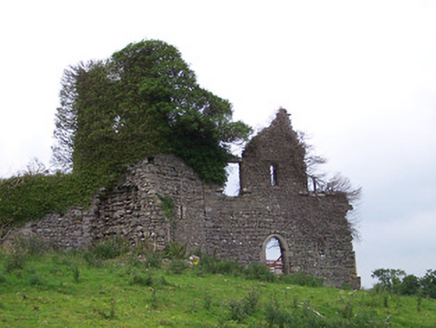Survey Data
Reg No
15306022
Rating
Regional
Categories of Special Interest
Archaeological, Architectural, Artistic
Original Use
Folly
In Use As
Folly
Date
1790 - 1810
Coordinates
266591, 268196
Date Recorded
29/07/2004
Date Updated
--/--/--
Description
Detached Gothick 'sham ruin' folly, built c.1800, comprising two storey tower on octagonal plan with base batter and an attached one and a half storey wall on irregular plan. Wall to south of tower is constructed to look like the remains of a gable end of a building. Tower is now partially collapsed and covered in ivy. Constructed of limestone rubble with ashlar trim to openings. The collapsed splayed base reveals an unusual construction of alternative flat stones with rounded stone infill. Narrow square-headed opening flanked by two larger square-headed openings with moulded stone hoodmouldings to first floor of 'gable'. Loop hole openings to ground floor of tower, some with brick surrounds, quatrefoil openings above to first floor. Pointed-arched doorcase with moulded stone surrounds to centre of 'gable' wall. Folly is located to the northeast of Killua Castle, creating a designed vista from the castle, and forms entrance to extensive walled garden complex.
Appraisal
An interesting 'sham ruin', designed to look like the remains of a medieval castle/building. It was constructed by Sir Benjamin Chapman of Killua Castle c. 1800. Structures of this type were a popular feature of many large demesne landscapes, particular in the late eighteenth and early nineteenth-century. They were mainly built as 'eye-catchers' to create a interesting and romantic vista from the main house. They were also a conspicuous display of great wealth. Probably the most famous example of a folly of this type in County Westmeath is the so-called 'Jealous Wall' found at Belvedere to the south of Mullingar. According to local tradition the carved stone surrounds found around the openings at this folly at Killua were brought from the remains of the medieval Franciscan Friary at Multyfarnham. This reuse of historic fabric is of archaeological significance. Benjamin Chapman also reused medieval church fabric in another 'ruin', St. Lua's Church, which is to the south-east of the demesne. This folly forms part of an important group of demesne-related structures within the former Killua Castle Demesne and creates a romantic feature in the landscape.

